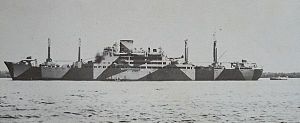Aikoku Maru (1940)
 Aikoku Maru in Singapore in 1942
| |
| History | |
|---|---|
| Name | Aikoku Maru |
| Ordered | 1937 fiscal year |
| Builder | Tamano, Okayama |
| Laid down | 29 December 1938 |
| Launched | 25 April 1940 |
| Completed | 31 August 1941 |
| Stricken | 31 March 1944 |
| Fate | Sunk by air attack, 16 February 1944 |
| General characteristics | |
| Type | Armed merchant cruiser |
| Tonnage | 10,438 GRT |
| Length | 160.8 m (527 ft 7 in) w/l |
| Beam | 20.2 m (66 ft 3 in) |
| Draught | 8.8 m (28 ft 10 in) |
| Propulsion |
|
| Speed | 20.9 knots (38.7 km/h; 24.1 mph) |
| Complement | 133 |
| Armament |
|
| Aircraft carried | 1 × Kawanishi E7K floatplane |
| General characteristics (after 1942) | |
| Armament |
|
| Aircraft carried | 2 × Aichi E13A floatplanes |

Aikoku Maru (愛国丸) was an
Design
Aikoku Maru was laid down at the
She was designed to be a combined
Although ostensibly a luxury ocean liner, the military had a say in the design of Aikoku Maru with an eye towards its future use as a troop transport. Provision was made for landing craft and for the anchoring of naval artillery.
Operational history
Immediately on completion on 31 August 1941, Aikoku Maru was officially requisitioned by the Imperial Japanese Navy. She was converted into an
As an auxiliary cruiser and submarine tender
On 15 October 1941, the 24th Raider Squadron (CruDiv24), consisting of Aikoku Maru, Hōkoku Maru, and Kiyosumi Maru was created under the Combined Fleet. Aikoku Maru and her sister ship Hōkoku Maru were forward deployed to Jaluit Atoll in the Marshall Islands at the end of November in preparation for the upcoming hostilities against the United States.[2]
On 13 December 1941, Aikoku Maru and Hōkoku Maru sank SS Vincent (6,210 GWT), an American merchant vessel with a cargo of rice from Australia to
On 14 February 1942, at
After repairs at
From September, Aikoku Maru was assigned to the

On 11 November, the raiders attacked the Dutch tanker
As a military transport
From 16 December 1942, Aikoku Maru was reassigned back to the IJN 8th Fleet, primarily as a military transport to support
As part of "Operation C" (the Reinforcement of New Guinea), on 5 January 1943, Aikoku Maru loaded the IJAAF 209th Airfield Battalion, 14th Aerial Repair Shop and others, a total of 691 men plus 34 vehicles at
On 10 July 1943, as part of a convoy including the aircraft carrier Un'yō, Aokoku Maru was attacked by the submarine USS Halibut 170 nautical miles (310 km; 200 mi) north of Truk, which fired six torpedoes. One struck Aikoku Maru, causing moderate damage. On her return voyage, on 15 July, she was attacked again, this time by the submarine USS Tinosa, whose four torpedoes all missed. She returned to Kure on 2 September.[2]
On 6 October, Aikoku Maru returned to Tamano for repairs and refitting with additional weaponry, which included two 152 mm guns and four twin-mount Type 96s. The refitting work was completed by 31 December 1943.

On 21 January 1944, Aikoku Maru loaded the 629 men of the 66th Naval Guard Unit, with ammunition, supplies and construction materials. The convoy was attacked 300 nautical miles (560 km; 350 mi) northwest of Truk by the submarine
Aikoku Maru was removed from the
Shipwreck
The wreck of Aikoku Maru is a popular
On 17 February 1994, a memorial monument was placed on Aikoku Maru′s deck at a depth of approximately 38 metres (125 ft). The monument was a joint project of the Chuuk Visitors Bureau,
Notes
- ^ Lindemann, p. 145
- ^ a b c d e f g [1] CombinedFleet.com: Aikoku Maru Tabular Record of Movement
- ^ Cressman, The Official Chronology of the U.S. Navy in World War II; page 68
- ^ Boyd, The Japanese Submarine Force and World War II; page 90
- ^ Visser, Jan (1999–2000). "The Ondina Story". Forgotten Campaign: The Dutch East Indies Campaign 1941–1942. Archived from the original on 21 March 2011.
- ^ Pacific Wrecks
- ^ Jackson, Top Wreck Dives of the World; page 127
- ^ Larry McLean, S.S. Thorfinn Crew and monument placer
References
- Boyd, Carl (2002). The Japanese Submarine Force and World War II. Naval Institute Press. ISBN 1557500150.
- Cressman, Robert (1999). The Official Chronology of the U.S. Navy in World War II. Naval Institute Press. ISBN 1557501491.
- Jackson, Jack (2007). Top Wreck Dives of the World. New Holland Publishers. ISBN 978-1845374662.
- L, Klemen (2000). "Forgotten Campaign: The Dutch East Indies Campaign 1941–1942".
- Lindemann, Klaus (2005). ISBN 1-59752-347-X.
- Parshall, Jon; Bob Hackett; Sander Kingsepp; Allyn Nevitt. "CombinedFleet.com: Aikoku Maru Tabular Record of Movement".
Further reading
- Bailey, Dan E. (1992). World War II: Wrecks of the Kwajalein and Truk Lagoons. North Valley Diver Publications. ISBN 0-911615-05-9.
- Gardner, Robert (1985). Conway's All the World's Fighting Ships 1906–1921. Conway Marine Press. ISBN 0851772455.
- Morison, Samuel Eliot (1961). Aleutians, Gilberts and Marshalls, June 1942 – April 1944, History of United States Naval Operations in World War II. Boston: Little, Brown and Company. ASIN B0007FBB8I.
- Stewart, William Herman (1986). Ghost Fleet of the Truk Lagoon: An Account of "Operation Hailstone", February, 1944. Pictorial Histories. ISBN 0-933126-66-2.
